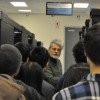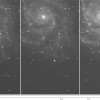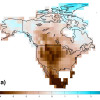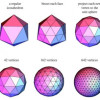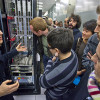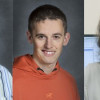News
Computing steps up to capture, keep carbon dioxide underground
Producing electricity to power our homes and businesses while also reducing carbon dioxide emissions remains difficult. Fossil fuels provide most electricity in the United States. Coal-burning plants produce nearly three quarters of the nation’s power, simultaneously spewing carbon dioxide into the atmosphere. - See more at: http://ascr-discovery.science.doe.gov/feature/carbon1.shtml#sthash.TWMdavSb.dpuf Read More »
Inspiring Careers in Science Research
In an effort to expose high school students to careers in research, the Lawrence Berkeley National Laboratory’s (Berkeley Lab) Computing Sciences Diversity Outreach Program partnered with San Francisco’s Lowell High School Science Research Program, an after school program that aims to give highly motivated juniors and seniors a chance to develop research projects with professional guidance with the intent to have the students enter the Intel Science Talent Search, a competition sponsored by Intel that offers college scholarships for outstanding scientific work. Read More »
Calculating What’s in the Universe from the Biggest Color 3-D Map
Since 2000, the three Sloan Digital Sky Surveys (SDSS I, II, III) have surveyed well over a quarter of the night sky and produced the biggest color map of the universe in three dimensions ever. Read More »
Closest Type la Supernova in Decades Solves a Cosmic Mystery
Type Ia supernovae (SN Ia’s) are the extraordinarily bright and remarkably similar “standard candles” astronomers use to measure cosmic growth, a technique that in 1998 led to the discovery of dark energy – and 13 years later to a Nobel Prize, “for the discovery of the accelerating expansion of the universe.” The light from thousands of SN Ia’s has been studied, but until now their physics – how they detonate and what the star systems that produce them actually look like before they explode – has been educated guesswork. Read More »
A Better Way to ID Extreme Weather Events in Climate Models
You’d think that spotting a category 5 hurricane would never be difficult. But when the hurricane is in a global climate model that spans several decades, it becomes a fleeting wisp among mountains of data. Read More »
Today’s Severe Drought, Tomorrow’s Normal
While the worst drought since the Dust Bowl of the 1930s grips Oklahoma and Texas, scientists are warning that what we consider severe drought conditions in North America today may be normal for the continent by the mid-21st century, due to a warming planet. Read More »
Supercomputers Take a Cue from Microwave Ovens
As sophisticated as modern climate models are, one critical component continues to elude their precision—clouds. Simulating these fluffy puffs of water vapor is so computationally complex that even today’s most powerful supercomputers, working at quadrillions of calculations per second, cannot accurately model them. Read More »
Berkeley Lab Reaches Out to Women in Computing
Although women comprise the majority of the United States labor force, 60 percent of college graduates in developed countries, most of the of Internet users, and start the majority of new companies created each year in the US, they have made surprisingly few inroads into high performance computing, according to a recent HPC Wire editorial. Berkeley Lab is working to increase the number of women in computer science and HPC applying to work at the Lab. Read More »
New Scientific Networking Division Created as Home to ESnet
ESnet, the U.S. Department of Energy’s Energy Sciences Network, will become the core of the newest scientific division at Lawrence Berkeley National Laboratory, Berkeley Lab Director Paul Alivisatos announced Monday, Nov. 21. The new scientific networking division will report to Kathy Yelick, Associate Laboratory Director for Computing Sciences. Read More »
Computing Tools Speed Search for New Porous Materials
A team of researchers from Lawrence Berkeley National Laboratory and the University of California at Berkeley are building a suite of computational tools to help in the search for new porous materials. These synthetically created materials can play key roles in physical and chemical processes, including petroleum refinement, water softening and in separations. One class, known as zeolites, has a commercial impact of about $350 billion annually. Read More »







 Instagram
Instagram YouTube
YouTube
